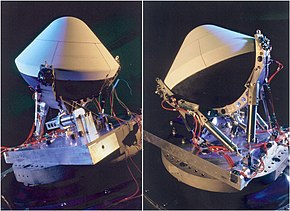Deep Space 2
 DS2 probe with heatshield and mounting | |||||||||||
| Mission type | Lander / impactor | ||||||||||
|---|---|---|---|---|---|---|---|---|---|---|---|
| Operator | NASA / JPL | ||||||||||
| Website | nmp.jpl.nasa.gov/ds2/ | ||||||||||
| Mission duration | 334 | ||||||||||
| Spacecraft properties | |||||||||||
| Manufacturer | Lockheed Martin Space Systems | ||||||||||
| Launch mass | 2.4 kg (5.3 lb) each | ||||||||||
| Power | 300mW Li-SOCl2 batteries | ||||||||||
| Start of mission | |||||||||||
| Launch date | 20:21:10, January 3, 1999 | ||||||||||
| Rocket | Delta II 7425 | ||||||||||
| Launch site | Cape Canaveral AFS SLC-17 | ||||||||||
| End of mission | |||||||||||
| Disposal | failure in transit | ||||||||||
| Last contact | 20:00, December 3, 1999[1] | ||||||||||
| Mars impactor | |||||||||||
| Spacecraft component | Amundsen and Scott | ||||||||||
| Impact date | ~20:15 UTC ERT, December 3, 1999 | ||||||||||
| Impact site | 73°S 210°W / 73°S 210°W (projected) | ||||||||||
| Transponders | |||||||||||
| Band | S-band | ||||||||||
| Bandwidth | 8 kbit/s | ||||||||||
| |||||||||||
 Mars Surveyor 98 mission logo | |||||||||||
Deep Space 2 was a NASA probe part of the New Millennium Program. It included two highly advanced miniature space probes that were sent to Mars aboard the Mars Polar Lander in January 1999.[2] The probes were named "Scott" and "Amundsen", in honor of Robert Falcon Scott and Roald Amundsen, the first explorers to reach the Earth's South Pole. Intended to be the first spacecraft to penetrate below the surface of another planet, after entering the Mars atmosphere DS2 was to detach from the Mars Polar Lander mother ship and plummet to the surface using only an aeroshell impactor, with no parachute. The mission was declared a failure on March 13, 2000, after all attempts to reestablish communications following the descent went unanswered.[3]
Background
Each probe weighed 2.4 kg (5.3 lb) and was encased in a protective aeroshell. They rode to Mars aboard another spacecraft, the Mars Polar Lander. Upon arrival near the south polar region of Mars on December 3, 1999,[2] the basketball-sized shells were released from the main spacecraft, plummeting through the atmosphere and hitting the planet's surface at over 179 m/s (590 ft/s). On impact, each shell was designed to shatter, and its grapefruit-sized probe was to punch through the soil and separate into two parts. The lower part, called the forebody, was designed to penetrate as far as 0.6 meters (2 ft 0 in) into the soil. The upper part of the probe, or aftbody, was designed to remain on the surface in order to radio data to the Mars Global Surveyor spacecraft in orbit around Mars. The Mars Global Surveyor would act as a relay in order to send the data collected back to Earth. The two sections of the probe were designed to remain connected via a data cable.[3]
Mission failure
The probes reached Mars apparently without incident, but communication was never established after landing. It is not known what the cause of failure was. The crash review board[4] suggests several possible causes for failure:
- the probe radio equipment had a low chance of surviving the impact.
- the probes may simply have hit ground that was too rocky for survival.
- The batteries on the probes, which had been charged prior to launch almost a year earlier, might not have retained sufficient power.
See also
- Exploration of Mars
- Deep Space 1
- List of missions to Mars
- Schiaparelli EDM lander (2016 Mars landing demonstrated that crashed)
- List of spacecraft powered by non-rechargeable batteries
References
- ^ Phil Davis; Kirk Munsell (23 January 2009). "Missions to Mars: Mars Polar Lander - Key Dates". Solar System Exploration. NASA. Retrieved 2009-04-22.
{{cite web}}: CS1 maint: multiple names: authors list (link) - ^ a b Davis, Phil; Munsell, Kirk (January 23, 2009). "Missions to Mars: Deep Space 2 - Key Dates". Solar System Exploration. NASA. Retrieved July 8, 2009.
- ^ a b "Deep Space 2 (DEEPSP2)". NSSDC Master Catalog. NASA - National Space Science Data Center. 2000. Retrieved July 8, 2009.
- ^ "Report on the Loss of the Mars Polar Lander and Deep Space 2 Missions" (PDF). Jet Propulsion Laboratory. 22 March 2000.
- ^ Young, Thomas (March 14, 2000). "Mars Program Independent Assessment Team Summary Report". Draft #7 3/13/00. House Science and Technology Committee. Retrieved April 22, 2009.
{{cite journal}}: Cite journal requires|journal=(help)
Bibliography
- Michael C. Malin (July 2005). "Hidden in Plain Sight: Finding Martian Landers". Sky and Telescope. 110 (7): 42–46. ISSN 0037-6604.
- "Press Kit: 1998 Mars Missions" (.PDF) (Press release). National Aeronautics and Space Administration. December 8, 1998. Retrieved April 22, 2009.
External links
- Deep Space 2 website at JPL








